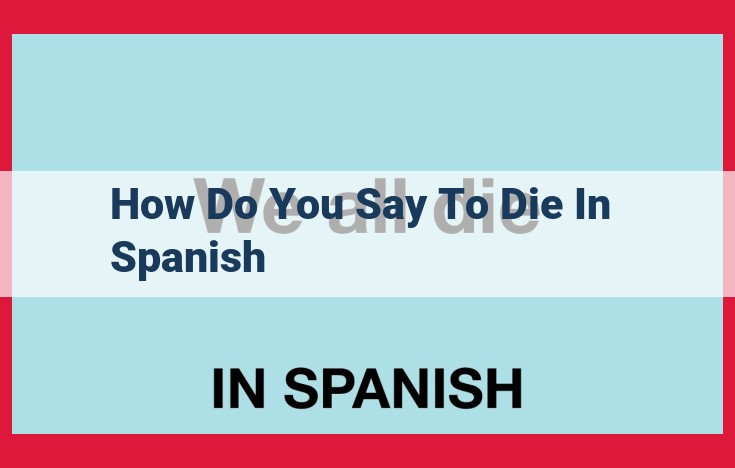Morir, meaning “to die” in Spanish, is a somber term that encompasses various aspects of the end of life. Its cognates, “fallecer” and “expirar,” carry similar meanings, while “perecer” denotes a more tragic or violent death. Spanish also has specific nouns for death itself, such as “muerte,” “defunción,” and “fallecimiento.” Adjectives like “mortal” emphasize the inevitability of death, while phrases like “morir de hambre” illustrate its metaphorical uses.
Exploring the Language and Concepts of Death in Spanish
Understanding the nuances of death-related terminology in Spanish is essential for navigating conversations and cultural interactions. Let’s delve into the diverse words, phrases, and their cultural significance.
Verbs of Dying:
The language of death encompasses a range of verbs that describe the act of dying itself. “Morir” and “fallecer” are commonly used to convey the final departure from life. “Expirar” and “perecer” have more formal tones, often employed in legal or historical contexts. Understanding these verbs allows you to express condolences and engage in discussions about the end of life.
Nouns for Death:
Spanish has several nouns that refer specifically to death. “Muerte” is the most direct and frequently used term. “Defunción” implies a more technical or legal context, while “fallecimiento” carries a respectful and formal tone. These distinctions help you communicate appropriately in various settings.
Adjectives Related to Death:
Descriptive adjectives are crucial for conveying the characteristics associated with death. “Mortal” emphasizes the temporary nature of our existence, while “fatídico” denotes a tragic or fateful occurrence. “Terminal” signifies the final stage of an illness. These adjectives add depth and emotion to conversations about life’s end.
Phrases Related to Dying:
Figurative phrases often use verbs of dying in creative ways. “Morir de hambre” literally means “to die of hunger,” but figuratively conveys extreme deprivation. “Despedirse del mundo” translates to “to say goodbye to the world,” expressing the act of passing away. These phrases offer insight into the cultural perspectives on death and human mortality.
Día de los Muertos: A Vibrant Celebration of the Dead
In the heart of Mexico, the Día de los Muertos (Day of the Dead) unfolds as a vibrant and lively festival. This unique holiday honors and celebrates the lives of departed loved ones, creating a bridge between the realms of the living and the dead.
During this time, the walls between worlds blur as families erect elaborate altars, or ofrendas, adorned with marigolds, candles, and offerings of food, drink, and personal belongings. These altars serve as invitations for the spirits to visit, sharing in the laughter, memories, and traditions of the living.
Calaveras: Artistic Symbols of Life and Death
The Día de los Muertos is renowned for its whimsical and often macabre imagery. Calaveras (skulls) and skeletons dance and celebrate in vibrant colors, representing the cyclical nature of life and death.
These artistic expressions remind us that death is not a somber end but rather a continuation of the journey. Skulls adorned with flowers and smiles symbolize the beauty and acceptance of mortality.
Panteón: The Sacred Sanctuary of the Departed
In Spanish-speaking cultures, the panteón (cemetery) is more than a burial ground; it is a sacred space where the living connect with their departed. Intricate mausoleums and headstones adorn the grounds, creating a labyrinth of memories and stories.
Families gather at the gravesides, decorating them with flowers, sharing meals, and playing music. The panteón becomes a sanctuary for the living to grieve, remember, and celebrate the lives of their loved ones.
Tumba and Mausoleo: Majestic Repositories of the Past
A tumba (tomb) serves as the final resting place for the deceased, often adorned with inscriptions and epitaphs that tell the story of the life that once was. It is a place of remembrance and contemplation, where loved ones come to pay their respects.
A mausoleo (mausoleum) takes tomb architecture to grander heights. These elaborate structures are often constructed as memorials to the deceased, showcasing architectural prowess and symbolizing the lasting legacy of those who lie within.
Literary and Artistic Motifs of Death
Throughout history, humankind has grappled with the inevitability of death through various literary and artistic expressions. This article delves into three prominent motifs that explore the themes of mortality, the transience of life, and the dance between life and death.
Memento Mori: Remembering Death
The concept of memento mori, or “remembering death,” has been a prevalent theme in art and literature for centuries. This Latin phrase reminds us of our own mortality and encourages us to live life to the fullest while acknowledging its inevitable end. In art, memento mori often takes the form of skulls or other symbols of death, serving as a constant reminder of the fragility of human existence.
Vanitas: The Transience of Life
Vanitas is an artistic genre that flourished during the 17th century. It uses symbolism and imagery to depict the futility of worldly possessions and pleasures. Vanitas paintings typically feature objects associated with wealth and status, such as gold coins, jewels, and musical instruments, juxtaposed with symbols of death, such as skulls and withered flowers. This juxtaposition highlights the transient nature of life and the ultimate vanity of earthly pursuits.
Danza de la Muerte: The Dance of Death
During the Middle Ages, the Dance of Death emerged as a popular artistic motif. It depicts personified Death leading individuals from all walks of life in a dance, regardless of their age, status, or wealth. This motif serves as a reminder that death is universal and that all mortals must eventually face it. The Dance of Death often features skeletons or ghoulish figures, creating a macabre yet thought-provoking representation of the leveling power of death.
These literary and artistic motifs provide a window into humanity’s collective fascination with death and its profound impact on our lives. They remind us of the ephemeral nature of existence, encourage us to cherish the present moment, and ultimately remind us that in the face of death, we are all equal.
